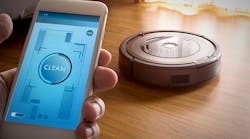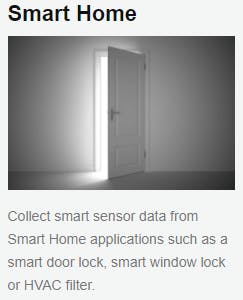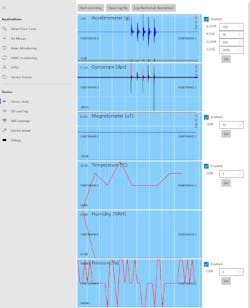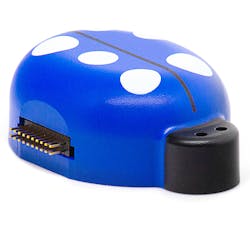Using Multi-sensor Solutions to Develop Intelligent Control Systems
What you’ll learn:
HVAC filter monitoring: Pressure sensors for differential pressure measurement to detect if the filter needs to be replaced.
Door Open/Close in Industrial/Medical Facilities: In strong controlled environments, a door being opened can change the humidity, temperature and can also lead to leak of chemicals. Hence the door open/close needs to be accurately tracked using Motion sensors for environmental control.
Presence Detection in Smart-Homes/Industries: Based on human presence, the appropriate environmental settings in a room can be enabled. The presence can be accurately detected using an ultrasonic sensor
Vibration Detection in Labs/Testing Facilities: Environments with vibrations can be detected accurately using motion sensors. MEMS based motion sensors can catch the vibration frequencies and give us a sense of the vibration in the environment.
Smart-Health: Maintaining barometric pressure in a room is very critical for patients suffering from sleep apnea or from high pressure exposure in water. Pressure sensors can help regulate the environmental pressure
Environmental sensing is becoming increasingly fine-grained. Weather satellites have been in operation since 1960 and marked the beginning of climate research using meteorological technology from space. Today, we can use environmental sensors to control the temperature and humidity in areas as small as individual rooms.
However, creating intelligent environment sensing systems that provide convenience with optimized energy usage is a major challenge today. Environmental systems that control heating, ventilation and air conditioning, or HVAC, are estimated to represent around 50% of a commercial building’s total energy usage (U.S. Department of Energy figures). In addition, the control systems today have a huge latency associated with heating and cooling large areas, especially in rooms that require quick, flexible, and reconfigurable control. Delivering the highest efficiency requires more than just a simple timer or a thermostat.
There is another dimension to the challenge. These systems do not operate optimally all the time. They encompass many moving parts, which wear out, as well as filters, which become blocked and need replacing. As these physical and mechanical elements wear, a system’s efficiency drops. This can be avoided by using sensors that detect changes in air flow rate, or the fatigue of mechanical components through the analysis of audible noise or vibration patterns
Occupancy is another factor. The randomness of people exposes the difficulty in predicting when a space will or will not be in use. At any time in a working day, large parts of a commercial building may be unused. This makes scheduling HVAC cycles based on timers alone problematic and prone to error.
Consequently, monitoring environmental factors such as occupancy, air pressure and motor vibration are becoming increasingly important, to better monitor and manage room temperature. In industrial and medical environments, it can be important to also sense, monitor, and control air pressure humidity levels, and air quality (gas composition). Managing these parameters has been shown to promote wellbeing and it is becoming more common to monitor these same parameters in other types of buildings, such as offices and homes.
Smart Environment management systems using multiple sensors are now being developed to address these challenges. The importance of raising energy efficiency in public and private buildings is an incentive, but legislation is now being developed to mandate a more responsible attitude towards energy consumption, health, and wellbeing.
Control systems for indoor environments typically operate in a closed loop. This means using some form of feedback to modify an input, to control an output. One of the biggest trends in control theory today is machine learning and multi-sensor fusion, which can revolutionize the way energy efficiency is addressed.
Machine learning-based systems rely on extensive amounts of data. This data is generally acquired by multiple sensors to make intelligent decisions. These machine learning systems use sensor fusion to combine multi-sensor inputs and generate the corresponding meta data. This meta data can then be used to train machine-learning models that can subsequently be deployed in control systems to make real-time intelligent decisions based on changing input parameters. As the sensor parameters vary, these models learn to adapt, making smarter decisions and taking effective actions to achieve energy efficiency.
The action taken may be to reduce or increase heating in a particular area, but it would be based not simply on the time of day, but on the current or expected level of usage, the outside temperature, time of year, and even the short-term weather forecast, for example.
Using multiple sensors in this way is a departure from the simple closed-loop system, which may only use a thermostat to turn the heating up or down. The thermostat is, of course, still an effective form of control, but it cannot take into account or learn from critical factors, such as the thermal lag involved, latent heat, the effect of opening or closing windows or, just as fundamental, the level of occupation.
More sophisticated control systems for indoor environments take all this multi-sensor data into account when deciding if to increase or decrease the amount of energy directed towards heating or cooling. It would also be relevant in maintaining the appropriate humidity levels, air quality levels or barometric pressure.
The source of sensor data and how it is used
There are good reasons for sensing and capturing data from multiple sensors. It provides the necessary input to control systems and in this scenario the data is historical – it may only be seconds old, but it is still historical. However, correlating historical data is now used increasingly to predict the future. Predictive maintenance and condition monitoring are now important aspects of achieving energy efficiency goals.
This involves more varieties of sensors, along with intelligent corresponding algorithms, that can provide meaningful insights from sensor data. In an HVAC system, for example, it may include using temperature sensors placed strategically around the system to measure the air temperature and the temperature of the water or other liquid used. The pressure of the liquid may also need to be measured for control purposes, but a more intelligent system may use multiple pressure sensors to provide differential pressure measurements, to monitor the system's condition over time. Pressure sensors are also useful to measure the airflow at various points in the system for filter condition monitoring. In addition, gas sensors are useful in monitoring air quality by measuring the composition of air on either side of the filter.
These systems work around people, so, logically, people should be part of the feedback loop. This involves monitoring the movement of people in a non-intrusive way, as it is only necessary to identify the presence and movement of people, not specific individuals. This makes the task a lot simpler, as there are many ways this can be achieved. Monitoring access points is one way of nonintrusive measurement. Most spaces have doors which tend to be kept closed, so by detecting doors that are opened, control systems can infer that at least one person has either entered or exited an area. This level of access monitoring can easily be implemented using various types of sensors, such as vibration or motion sensors. They could also use IMU (inertial measurement unit) sensors that detect when the door is closed and how often it is opened.
This discloses some idea of the flow of traffic, but it doesn’t tell the whole story. Measuring occupancy using ultrasonic sensors is a well-established technique used in security systems. Ultrasonic sensors are also used to provide automation over lighting; if no occupants are detected in a room the lights are automatically turned off. These systems may still work on a timer, which can be annoying for people who have simply not moved for a period, leading the system to believe that the area is unoccupied. However, when used in conjunction with access monitoring, the overall system could work more reliably and intuitively.
Also, monitoring the health of appliances is critical to achieve energy efficiency. An abnormal vibration can be a sign of a faulty ball bearing, axle misalignment, or imbalance. High bandwidth accelerometers can provide useful data on vibration patterns in machines to predict such critical anomalies. This data in conjunction with data from microphones and temperature sensors can significantly improve energy efficiency and reduce maintenance costs of appliances and machines, especially in industrial environments.
Lastly, using a combination of humidity sensors, barometric pressure sensors, and gas sensors can monitor gas composition levels such as carbon monoxide, carbon dioxide, methane, and nitrogen as well as humidity and barometric pressure levels to promote both short- and long-term health benefits, by providing a cleaner and healthier environment.
These examples show how relatively simple sensor fusion can deliver accurate and useful data and not only enhance overall energy efficiency but also provide a cleaner and healthier environment.
Environmental data from sensors
The types of sensors used to gather environmental information are evolving. IMUs, pressure sensors, gas sensors, vibration accelerometers, and ultrasonic sensors are some of the key sensors today for intelligent environment monitoring and control. Developers are keen to take advantage of the data that these sensors provide. The sensing elements are now generally manufactured using MEMS technology (Micro-Electromechanical Machined System).
MEMS are incredibly small, extremely accurate and very stable. Based on the same processes used to manufacture integrated circuits, they also consume very low power and include all the circuitry needed to interface to a host processor. And at a low level, the sensors often generate a digital stream of data, typically in a serial format such as I2C or SPI.
Building complex control systems using the data generated by these sensors can still be a challenge. To simplify this, the industry is moving towards pre-configured systems that comprise multiple sensors in a single platform, which also integrates the software needed to provide an ‘out of the box’ experience.
Developers can use these pre-configured systems to start gathering data quickly and easily. The intention is to gather as much data as possible and use post-processing to evaluate the relevance and importance of data for a given application.
For example, a module that incorporates motion, pressure and directional sensing could be used to build a system designed to monitor access into a room, or even a building. The task of gathering the data is simplified through some form of wireless connectivity. A host computer would take the data and provide preliminary levels of processing, allowing developers and researchers to quickly draw conclusions through comparison and correlation. The software algorithms used to make sense of the raw data coming from the sensors are fully integrated into the module platform, so developers can simply configure the system at a high-level using scripts and then start capturing valuable data in real-time.
Platforms like this can accelerate the development cycle for new applications and innovative ways of measuring energy efficiency in environmental applications. The SmartBug from InvenSense, a TDK group company is an example of such a system. This multisensor wireless module incorporates multiple MEMS sensors such as IMUs, pressure sensors, humidity and temperature sensors, ultrasonic sensors, and magnetometers. In addition, algorithms such as sensor fusion, and wireless connectivity in a small, battery-powered format allow it to be deployed almost anywhere.
The unobtrusive nature of the platform means it can easily be used to capture real-world data and provide valuable insights and environmental signatures, leading to new ways of increasing energy efficiency.
Conclusion
Energy efficiency will remain a focus for many years. As we continue to demand more energy, we must also develop more efficient ways of preserving it. Global climate change is focusing minds, and legislation is introducing mandates that we must all follow. However, our lifestyles dictate a certain level of convenience that would be hard to remove. Developing more efficient ways of using energy will allow us to continue to enjoy these conveniences.
Access to real-world data through advanced sensors will help in the development of these more energy efficient control systems. Even a small percentage improvement can have a massive difference. Through platforms like SmartBug, we can accelerate the research and development process and achieve innovative solutions faster while moving us forward on a path of future sustainability.





